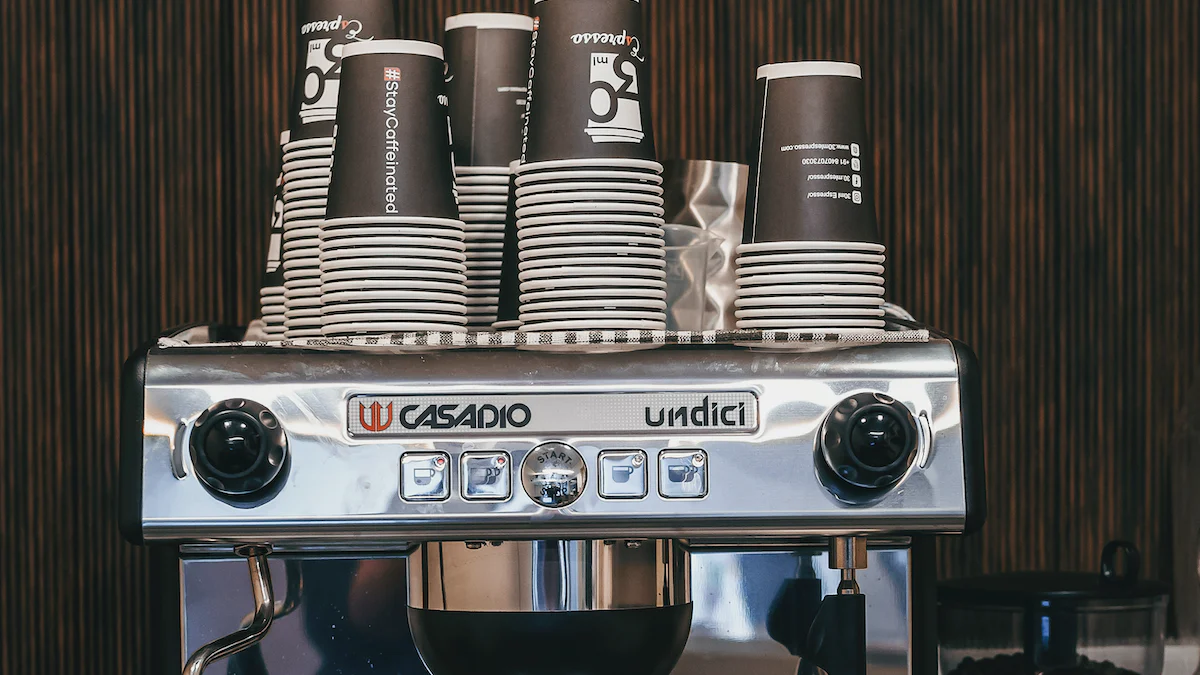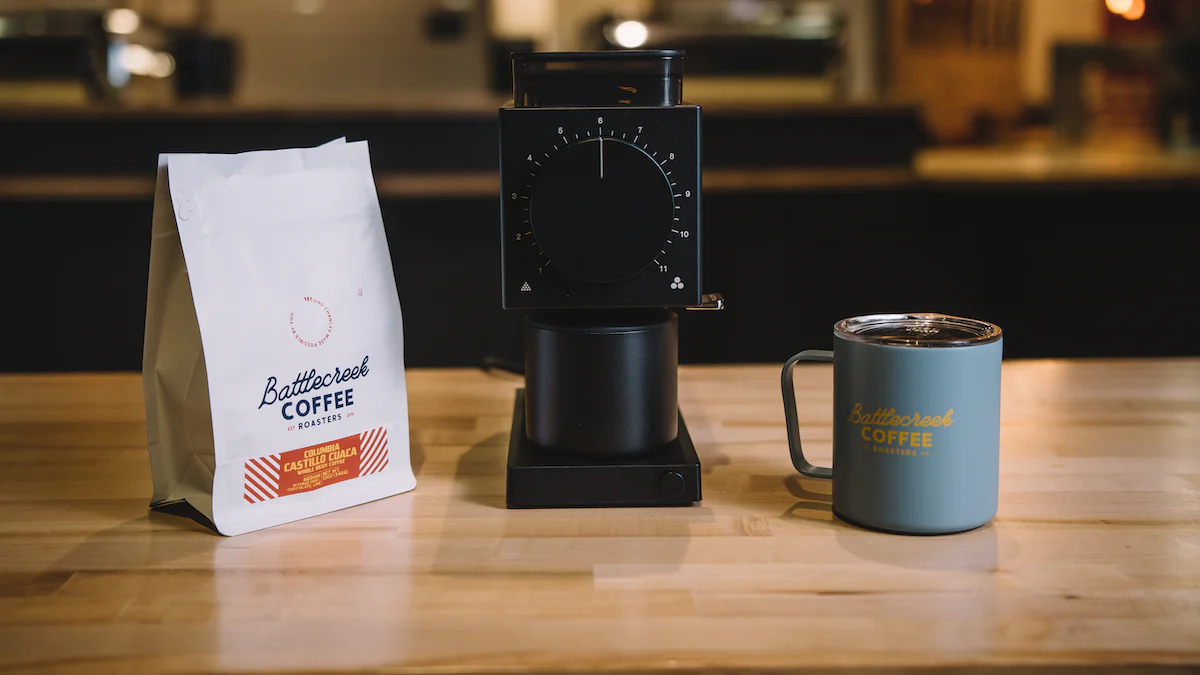FTC/ASA Disclosure: Some links in this post are affiliate links. At no additional cost to you, I will earn commission if you purchase via my links. Thank you in advance for your support! 🙏 It means a lot to me. ❤️
Coffee is one of the most popular beverages in the world, enjoyed by millions of people every day. It is made from the seeds of the Coffea plant, which are commonly referred to as coffee beans. However, within the world of coffee, there is a distinction between coffee beans and espresso beans. While they both come from the same plant, there are differences in their size, shape, and roasting methods that result in different flavors and characteristics. In this article, we will explore the differences between coffee beans and espresso beans, their origins, characteristics, roasting process, brewing methods, flavor profiles, caffeine content, uses in specialty drinks, price differences, and tips for choosing the right beans for your preferences.
Understanding the Difference Between Coffee Beans and Espresso Beans
Coffee beans and espresso beans are both derived from the seeds of the Coffea plant, but they have distinct differences. Coffee beans are typically larger in size and have a more oval shape, while espresso beans are smaller and rounder. Additionally, coffee beans tend to have a lighter color compared to espresso beans, which are darker and shinier.
One of the main differences between coffee beans and espresso beans lies in their roasting methods. Coffee beans are typically roasted for a longer period of time at lower temperatures, resulting in a lighter roast. This allows for more acidity and a brighter flavor profile. On the other hand, espresso beans are roasted for a shorter period of time at higher temperatures, resulting in a darker roast. This produces a more intense flavor with less acidity.
The Origins of Coffee Beans and Espresso Beans
Coffee has a rich history that dates back centuries. It is believed to have originated in Ethiopia, where it was discovered by a goat herder who noticed that his goats became more energetic after eating the berries from a certain tree. From there, coffee cultivation spread to other parts of Africa and eventually to the Middle East, where it became popular in Islamic culture.
Today, coffee is grown in many countries around the world, with Brazil being the largest producer. Other major coffee-producing countries include Colombia, Vietnam, Ethiopia, and Honduras. These countries have ideal climates and soil conditions for growing coffee beans.
Espresso beans, on the other hand, are not a specific type of coffee bean but rather a roast level. However, certain varieties of coffee beans are more commonly used for making espresso due to their flavor profiles and characteristics. Some popular varieties include Arabica and Robusta. Arabica beans are known for their delicate flavors and acidity, while Robusta beans have a stronger and more bitter taste.
The Characteristics of Coffee Beans and Espresso Beans
Coffee beans and espresso beans have distinct characteristics that contribute to their flavor profiles. Coffee beans tend to have a wide range of flavors, depending on factors such as the variety of the bean, the region it was grown in, and the roasting process. They can have notes of fruit, chocolate, nuts, caramel, and more. Coffee beans also have varying levels of acidity, which can range from bright and tangy to smooth and mellow.
Espresso beans, on the other hand, are known for their intense flavor and boldness. They often have a rich and full-bodied taste with notes of dark chocolate, caramel, and roasted nuts. Espresso beans also tend to have less acidity compared to coffee beans, which gives them a smoother and more balanced flavor.
The Roasting Process for Coffee Beans and Espresso Beans
The roasting process plays a crucial role in determining the flavor and aroma of coffee beans and espresso beans. There are different levels of roasting that result in different flavors and characteristics.
Light roast: This is the lightest roast level, where the beans are roasted for a shorter period of time at lower temperatures. Light roast coffee beans tend to have a higher acidity and a brighter flavor profile, with notes of fruit and floral.
Medium roast: This is the most common roast level for coffee beans. The beans are roasted for a longer period of time at slightly higher temperatures, resulting in a medium brown color. Medium roast coffee beans have a balanced flavor with moderate acidity and a fuller body.
Dark roast: This is the darkest roast level, where the beans are roasted for a longer period of time at higher temperatures. Dark roast coffee beans have a rich and bold flavor with low acidity and a heavy body. They often have notes of dark chocolate, caramel, and roasted nuts.
Espresso roast: This is a specific roast level that is used for making espresso. The beans are roasted for a shorter period of time at higher temperatures, resulting in a dark brown color. Espresso roast beans have a strong and intense flavor with low acidity and a full-bodied taste.
The roasting process can be done using different types of equipment, such as drum roasters or hot air roasters. Each method has its own advantages and can result in different flavors and characteristics.
The Brewing Methods for Coffee Beans and Espresso Beans
Coffee beans and espresso beans can be brewed using different methods, depending on the desired strength and flavor profile.
For coffee beans, some popular brewing methods include:
– Drip brewing: This is the most common method for brewing coffee. It involves pouring hot water over ground coffee beans in a filter, which then drips into a pot or carafe.
– French press: This method involves steeping ground coffee beans in hot water for several minutes before pressing down a plunger to separate the grounds from the liquid.
– Pour-over: This method involves pouring hot water over ground coffee beans in a filter that sits on top of a cup or carafe. The water slowly drips through the grounds, resulting in a clean and flavorful cup of coffee.
– Cold brew: This method involves steeping ground coffee beans in cold water for an extended period of time, usually overnight. The result is a smooth and less acidic cup of coffee.
For espresso beans, the most common brewing method is using an espresso machine. This involves forcing hot water through finely ground espresso beans under high pressure. The result is a concentrated shot of coffee with a rich and intense flavor.
The Flavor Profile of Coffee Beans and Espresso Beans
Coffee beans and espresso beans have distinct flavor profiles that can be identified through tasting notes.
Coffee beans often have a wide range of flavors, depending on factors such as the variety of the bean, the region it was grown in, and the roasting process. Some common tasting notes for coffee include:
– Fruity: Coffee beans can have notes of berries, citrus fruits, or tropical fruits.
– Chocolatey: Coffee beans can have notes of dark chocolate, milk chocolate, or cocoa.
– Nutty: Coffee beans can have notes of almonds, hazelnuts, or walnuts.
– Caramel: Coffee beans can have a sweet and caramel-like flavor.
– Floral: Coffee beans can have floral notes such as jasmine or lavender.
Espresso beans, on the other hand, are known for their intense flavor and boldness. Some common tasting notes for espresso include:
– Dark chocolate: Espresso beans often have a rich and dark chocolate flavor.
– Caramel: Espresso beans can have a sweet and caramel-like taste.
– Roasted nuts: Espresso beans often have notes of roasted nuts such as almonds or hazelnuts.
– Smoky: Espresso beans can have a smoky or roasted flavor.
The Caffeine Content of Coffee Beans and Espresso Beans
One of the main differences between coffee beans and espresso beans is their caffeine content. While both contain caffeine, espresso generally has a higher concentration of caffeine compared to regular coffee.
The caffeine content in coffee can vary depending on factors such as the variety of the bean, the brewing method, and the serving size. On average, an 8-ounce cup of coffee contains about 95 milligrams of caffeine. However, this can range from 30 to 200 milligrams depending on the factors mentioned above.
Espresso, on the other hand, is a concentrated shot of coffee that is typically served in a 1-ounce or 2-ounce serving size. A single shot of espresso contains about 63 milligrams of caffeine, while a double shot contains about 125 milligrams. This higher concentration of caffeine in a smaller serving size is what gives espresso its reputation for being strong and energizing.
It’s important to note that caffeine affects individuals differently, and some people may be more sensitive to its effects than others. It’s also worth mentioning that decaffeinated versions of both coffee and espresso are available for those who prefer to limit their caffeine intake.
The Uses of Coffee Beans and Espresso Beans in Specialty Drinks
Coffee beans and espresso beans are not only used to make regular cups of coffee and espresso but also play a key role in specialty drinks. These drinks often combine coffee or espresso with other ingredients to create unique flavors and textures.
Some popular specialty drinks made with coffee beans include:
– Cappuccino: This is a classic Italian drink made with equal parts espresso, steamed milk, and milk foam.
– Latte: This is a popular drink made with espresso and steamed milk. It can be flavored with syrups such as vanilla or caramel.
– Mocha: This is a drink made with espresso, steamed milk, and chocolate syrup or cocoa powder.
– Americano: This is a drink made by diluting espresso with hot water. It has a similar strength to regular brewed coffee but with a different flavor profile.
– Macchiato: This is a drink made with a shot of espresso topped with a small amount of foamed milk.
Espresso beans are commonly used to make these specialty drinks due to their intense flavor and concentration. However, coffee beans can also be used to create unique and flavorful drinks.
The Price Differences Between Coffee Beans and Espresso Beans
The price of coffee beans and espresso beans can vary depending on factors such as the variety of the bean, the region it was grown in, and the quality of the beans. However, there are some general trends when it comes to pricing.
In general, espresso beans tend to be more expensive than regular coffee beans. This is due to the higher quality and concentration of flavors in espresso beans. Additionally, the roasting process for espresso beans requires more precision and skill, which can also contribute to the higher price.
The price of coffee beans can vary depending on factors such as the variety of the bean and the region it was grown in. Arabica beans, which are known for their delicate flavors, tend to be more expensive than Robusta beans. Additionally, coffee beans that are grown in specialty regions or have certifications such as Fair Trade or Organic tend to have a higher price tag.
When it comes to finding the best deals on coffee beans and espresso beans, it’s worth exploring different brands and suppliers. Online retailers often offer a wide selection of beans at competitive prices. It’s also worth considering buying in bulk or subscribing to a coffee subscription service, which can offer discounts and convenience.
Choosing the Right Beans for Your Coffee Preferences
When choosing coffee beans or espresso beans, there are several factors to consider to ensure that you find the right match for your preferences.
Firstly, consider your preferred flavor profile. If you enjoy bright and fruity flavors, look for coffee beans with tasting notes of berries or citrus fruits. If you prefer a rich and chocolatey taste, opt for beans with notes of dark chocolate or cocoa. It’s also worth considering the acidity level and body of the beans, as these factors can greatly impact the overall flavor experience.
Secondly, consider your brewing method. Different brewing methods extract different flavors from the beans, so it’s important to choose beans that are suited to your preferred method. For example, if you enjoy making espresso, look for beans that are specifically labeled as espresso roast or have tasting notes that are well-suited to espresso.
Lastly, don’t be afraid to experiment and try different varieties of coffee beans and espresso beans. There is a wide range of flavors and characteristics to explore, and you may discover new favorites along the way. Consider trying single-origin beans, which are sourced from a specific region and often have unique flavor profiles.
Coffee beans and espresso beans may come from the same plant, but they have distinct differences in size, shape, roasting methods, flavor profiles, and uses. Coffee beans are typically larger and lighter in color, with a wider range of flavors and higher acidity. Espresso beans are smaller and darker in color, with a more intense flavor and lower acidity.
The roasting process plays a crucial role in determining the flavor and aroma of coffee beans and espresso beans. Different levels of roasting result in different flavors and characteristics, ranging from light and fruity to dark and smoky.
Both coffee beans and espresso beans can be brewed using various methods, each resulting in a unique flavor experience. Coffee beans are commonly brewed using methods such as drip brewing or French press, while espresso beans are typically used with an espresso machine.
When it comes to choosing the right beans for your preferences, consider factors such as flavor profile, brewing method, and experimentation. There is a wide variety of coffee beans and espresso beans available, each offering its own unique characteristics and flavors.
In conclusion, whether you prefer a bright and tangy cup of coffee or a bold shot of espresso, there is a world of flavors to explore with coffee beans and espresso beans. So grab your favorite brewing equipment, experiment with different varieties, and enjoy the rich and diverse world of coffee.
If you’re wondering whether coffee beans and espresso beans are the same, you might also be interested in learning about the different types of coffee beans and their effects on taste. This informative article from BrewHilda explores the various types of coffee beans and how they can impact the flavor profile of your brew. From bold and robust flavors to delicate and fruity notes, understanding the differences between coffee bean varieties can enhance your coffee-drinking experience. Check out the article here to delve deeper into the world of coffee bean diversity.
Brewhilda.com is a participant in the Amazon Services LLC Associates Program, an affiliate advertising program designed to provide a means for sites to earn advertising fees by advertising and linking to Amazon.com.










